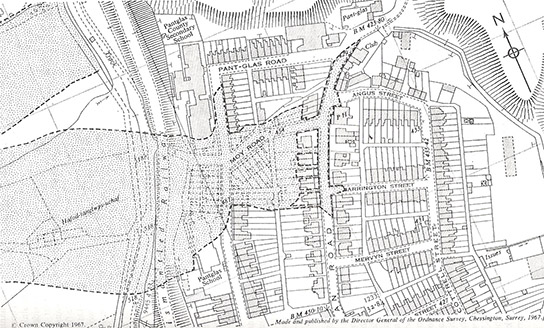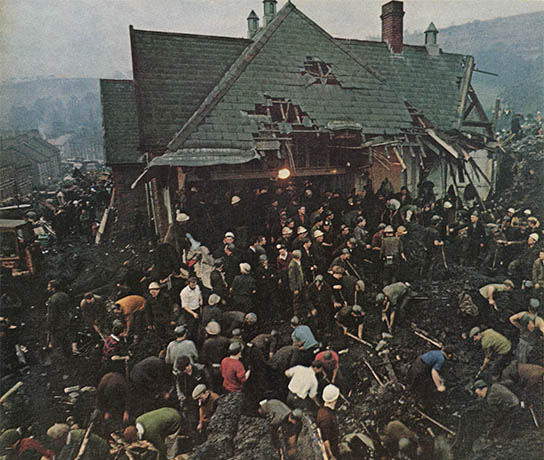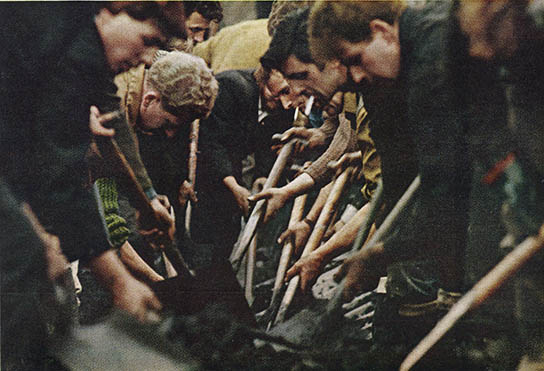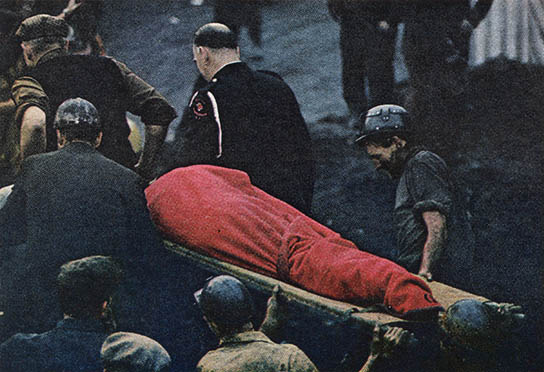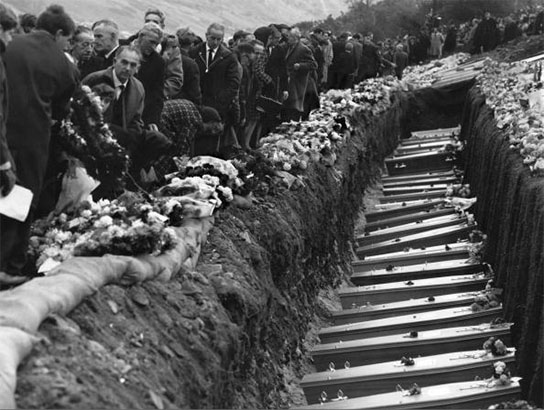The two vertical shafts of the Merthyr Vale Colliery, in the Taff River valley in Merthyr Tydfil, Glamorganshire, Wales, were sunk between 1869–1875. It was one of the largest of the hundreds of mines that opened during the industrial revolution to exploit the rich South Wales coalfield.1
The town of Aberfan was founded sometime in the early 1900s and by the 1960s nearly 80% of the men in the town worked at Merthyr Vale.
From the very beginning the excavated rock, slag and other mining debris from Merthyr Vale was deposited in a series of waste piles – or tips – on Mynydd Merthyr ridge. Tip no. 7, some 500 ft above the town, was started in early 1958 and was situated directly over natural springs in the sandstone bedrock. Although no. 7 had several minor slips over the years and the locals considered it unsafe, the tipping continued. By 1966 it was nearly 110 ft high and contained an estimated 300,000 m3 of waste, including nearly 30,000 m3 of particularly fine material known as tailings.
In the early morning hours of Friday, 21 Oct 1966 there was a small slip at no. 7. The tipping gang tried to alert someone by phone but the line had been stolen. By then, however, it was already too late: around 9:25 am some 150,000 m3 of sludge and waste, supersaturated from the underground springs and several days of heavy rains, broke free and surged down Mynydd Merthyr. As the tip chargehand said “all I can tell you is it was going down at a hell of a speed in waves.” On the way down the landslide destroyed two farmhouses and at the bottom of the hill it leveled 18 terrace houses (“like a pile of dominoes coming down” said one witness). It continued across Moy Road toward the Pantglas Junior School.2
Had the landslide occurred earlier the children would have been safely outside at assembly and had it occurred later they would have already left after a half-day for mid-term break. But instead at 9:25am the children were just returning to their classrooms.
Visibility that morning was so poor that no one could see up Myndd Merthyr, but as the children said, they could hear the landslide – as one teacher recalled it was a “terrible noise like a jet plane and I was afraid it was going to fall on the school.” Almost instantly some 40,000 m3 of sludge enveloped the school, destroying the building and burying the north classrooms under a 30 ft pile of slurry and debris.
And then there was absolute silence and “in that silence you couldn’t hear a bird or a child.”
Inquiry map showing extant of the landslide, from ref. 3
In the chaotic minutes directly after the landslide frantic mothers began digging for their children by hand. A general alarm was sounded and the colliers swarmed down from the mine to form organized digging gangs. They would spend the next 24 hours searching for survivors and recovering bodies.
News spread quickly and in many cases people simply dropped what they were doing, grabbed a shovel, and went to the Aberfan. By the next day the town was overrun with nearly 2000 volunteers, most of whom were just in the way of the organized rescue. But by then it didn’t matter – no child was pulled out of the school alive after 11:00 am on Friday. It would be a week before all the bodies were recovered.3
Mining the South Wales Coalfield has always been particularly dangerous; 259 men died at the Prince of Wales Colliery in 1878, 290 at Albion in 1894, 439 at Senghenydd in 1913 and 266 the Gresford in 1934, but Aberfan was something else altogether. In an inconceivably horrible twist of fate, the disaster had completely spared the miners and instead killed their children.
In all 144 people died in the landslide, including 116 children (109 7–10 year olds from the Junior School – almost half of its enrollment). In the span of five minutes the town had lost an entire generation.
Bentley Archive/Popperfoto. gettyimages.com
The Aberfan disaster was one of the first tragedies that was nationally televised and became the UK equivalent of the JFK assisination.4 The media scrum that descended on Aberfan was unprecedented and sadly, but predicability, much of the coverage was sensationalized and exploitative. One rescue worker recalled “...a photographer tell a kiddie to cry for her dead friends, so that he could get a good picture.” The images here were photographed for Life magazine by Terence Spencer and Marvin Lichtner.5
1. For more on the hundreds of Welsh mines see the appropriately named Welch Coal Mines.
2. For more on the disaster see: Austin, Tony. Aberfan: The Story of a Disaster. London: Hutchinson, 1967 (WorldCat) or McLean, Iain, Johnes, Martin. Aberfan: Disasters and Government. Cardiff: Welsh Academic Press, 2000 (WorldCat).
3. The official inquiry, chaired by Privy Councillor Lord Justice Edmund Davies lasted for 76 days. It concluded that the collapse of the tip was caused by a rotational slip which caused the saturated tailings to thixotropically modify (i.e., liquify) and flow down the hill. It also concluded that “the blame for the disaster rests upon the National Coal Board,” and furthermore “the Aberfan Disaster is a terrifying tale of bungling ineptitude by many men charged with tasks for which they were totally unfitted, of failure to heed clear warnings, and of total lack of direction from above.” See: Report of the tribunal appointed to inquire into the disaster at Aberfan on October 21st, 1966. London: Her Majesty's Stationary Office, 1967 (WorldCat, online). The figures and images are presented in higher resolution on Sedimentaryores.net.
4. See, e.g., the newsreel “This Is Tragedy.” British Pathe, 27 Oct 1966 (online).
5. “Disaster in Green Aberfan.” Life. 4 Nov 1966. Immediately after the disaster Life dispatched the 29 year-old photographer I. C. (Chuck) Rapoport to Wales from New York. Rapoport stayed long after the other media left, spending nearly a month in the town photographing not the disaster, but the people. The result was a moving series of photos capturing both the grief as well as the strength and courage of the residents. See: Rapoport, I. C. Aberfan: The Days After, A Journey in Pictures. Cardigan, Wales: Parthian Books, 2005 (WorldCat):

An Aberfan resident holding the Life issue
12 Mar 2010, updated 6 May 2015 ‧ Photography

